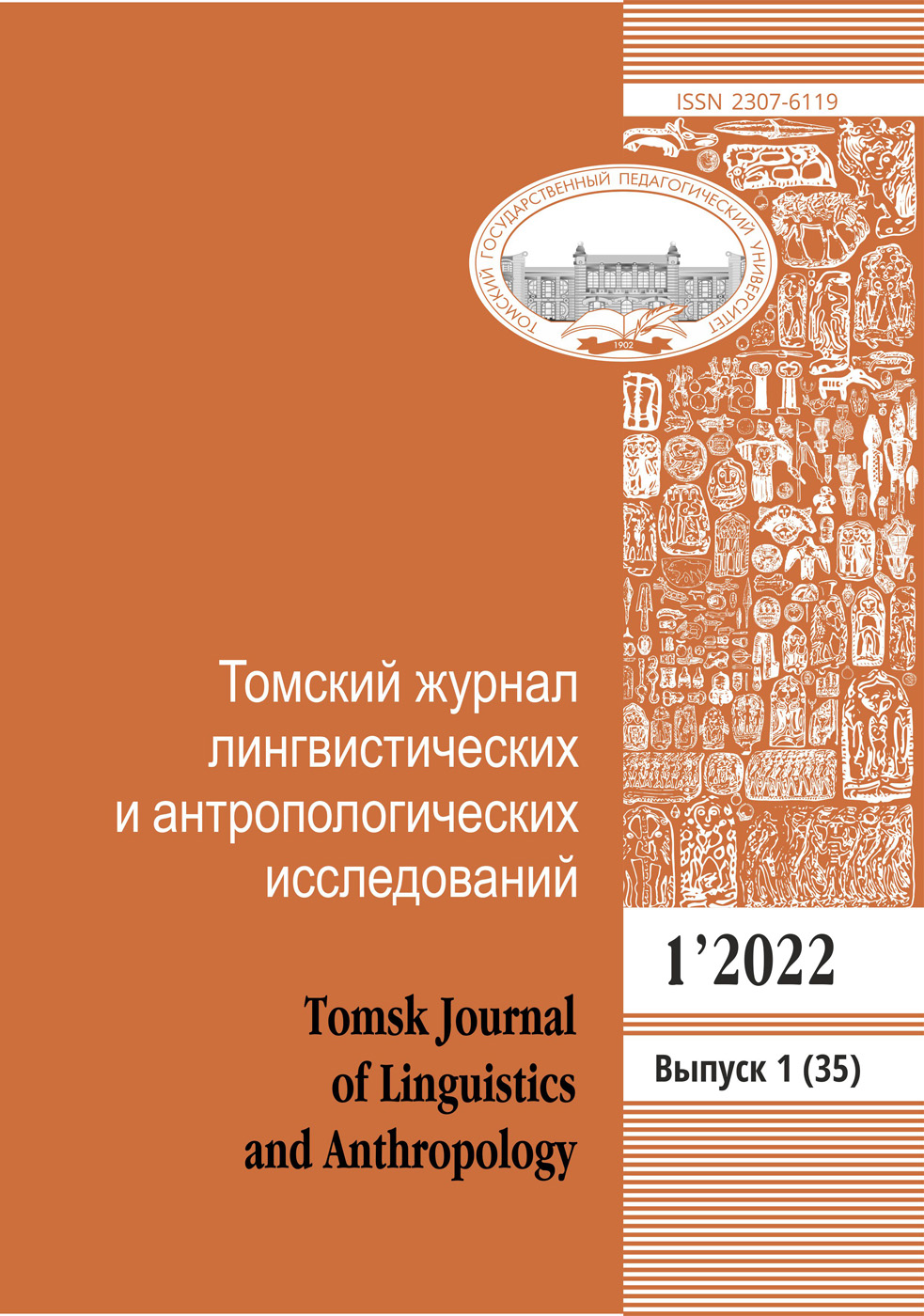INDIVIDUAL MEDIA DISCOURSE OF INFORMATIONAL AND MEDIA LANGUAGE PERSONALITY OF PRESENTER OF AUTHOR’S TV PROGRAM AS A FORM OF REPRESENTATION OF HIS INFORMATIONAL FIELD
DOI: 10.23951/1609-624X-2017-3-121-125
The authors specify the methodology of system analysis of author’s TV program presenter’s individual media discourse, taking into account understanding of individual media discourse as the representation form of his information field. Author-presenter’s professional speech behavior organizes his individual media discourse, determining the holistic well-known journalist’s image in circumstances of current discursive practice. At the same time specific peculiarities of his informational and media language personality’s idiostyle reflect in television journalists’s individual media discourse. Information field of media person is the space of communication which is organized in the process of different discoursive practices in media communication. The authors consider separately such components of media personality information field as: 1) reputation and authority; 2) citation (publicity, prominence); 3) thesaurus, view of the world and system of values. Authority of TV presenter is strongly correlated with reputation of program. Citation of TV journalist is the main indicator of his effective professional activity. Thesaurus, picture of the world and system of values of TV journalist reflects features of idiostyle of his media personality. This features are directly reflected in the individual media discourse. As the example, the authors analyze some peculiarities of television journalist and author’s TV program “Vesti nedeli” on TV channel “Rossiya 1” presenter D. Kiselev’s language personality information field.
Keywords: media discourse, individual media discourse of a TV journalist, informational field of personality, informational and media language personality, author’s TV program
References:
1. Bolotnova N. S. Metodiki smyslovogo i lingvopragmaticheskogo analiza mediateksta: uchebnoye posobiye [Methods of semantic and pragmaticlinguistic analysis of media text: tutorial]. Tomsk, Tomskiy TsNTI Publ., 2015. 156 p. (in Russian).
2. Bolotnov A. V. Types of informational and media personalities. Russkaya rechevaya kul’tura i tekst: materialy Mezhdunarodnoy nauchnoy konferentsii (17–18 aprelya 2014) – Russian speech culture and text: materials of International scientific conference (the 17–18 of April 2014). Tomsk, Tomskiy TsNTI Publ., 2014. Pp. 106–112 (in Russian).
3. Bolotnov A. V. Informatsionnoye pole i ego tipy v mediakommunikatsii: lingvisticheskiy aspect [Informational field and its types in media communication: linguistic aspect]. Vestnik Tomskogo gosudarstvennogo pedagogicheskogo universiteta – TSPU Bulletin, 2015, vol. 9 (162), pp. 28–33 (in Russian).
4. Bolotnov A. V. O nekotorykh klyuchevykh ponyatiyakh formiruyushcheysya informatsionno-mediynoy paradigmy v rusistike [Some key concepts of emerging information and media paradigm in Russian studies]. Voprosy kognitivnoy lingvistiki – Questions of cognitive linguistics, 2015, no. 1 (042), pp. 111–116 (in Russian).
5. Kashirin A. A. Kriterii kommunikativno-pragmaticheskogo analiza individual’nogo mediadiskursa telezhurnalista-vedushchego itogovoy informatsionno-analiticheskoy programmy [Criteria of the communicative and pragmatic analysis of the individual media discourse of a television presenter of the information and analytical program]. Vestnik Tomskogo gosudarstvennogo pedagogicheskogo universiteta – TSPU Bulletin, 2014, vol. 9 (150), pp. 70–75 (in Russian).
6. Kashirin A. A. O nekotorykh osobennostyakh individual’nogo mediadiskursa zhurnalista – vedushchego avtorskoy teleprogrammy [Some features of individual media discourse of presenter of author’s TV program]. Kommunikativnye issledovaniya – Communication Studies, 2015, no. 2 (4), pp. 75–85 (in Russian).
7. Radchenko E. I., Shevchenko A. A. Issledovaniye obraza “telezhurnalista” pri pomoshchi psikhosemanticheskogo analiza [Research of an image of “TV reporter” by means of the psychosemantic analysis]. APRIORI. Seriya: Gumanitarnye nauki – APRIORI. Series: Humanities, 2014, no. 2, pp. 21 (in Russian).
8. Nugumanova L. A. Neverbal’naya kommunikatsiya v televizionnom obshchenii [Non-verbal communication in a TV converse]. Sovremennye problemy nauki i obrazovaniya – Modern problems of science and education, 2013, no. 6, pp. 796 (in Russian).
9. Anokhin A. I. Spetsificheskiye osobennosti i vyrazitel’nye sredstva informatsionnogo televeshchaniya [Specific features and expressive means of informational television]. Vestnik Chuvashskogo universiteta – Bulletin of the Chuvash University, 2012, no. 1, pp. 276–280 (in Russian).
10. Vesti nedeli [News of the Week] (in Russian). URL: http://vesti7.ru/ (accessed 23.07.2016).
11. Dmitriy Kiselev: propaganda – eto prosto popytka chto-libo ob’yasnit’ [Dmitriy Kiselev: Propaganda – it is simply an attempt to explain anything] (in Russian). URL: http://www.bbc.com/russian/features/2016/06/160624_kiselev_interview (accessed 23.07.2016).
12. Kashirin A. A. Individual’nyy mediadiskurs zhurnalista – vedushchego avtorskoy teleprogrammy v aspekte vospriyatiya [Individual media discourse of a presenter of author’s TV program in the aspect of perception]. Vestnik Tomskogo gosudarstvennogo pedagogicheskogo universiteta – TSPU Bulletin, 2015, vol. 9 (162), pp. 49–52 (in Russian).
13. Sayt kompanii TNS [The site of TNS] (in Russian). URL: http://www.tns-global.ru/ (accessed 23.07.2016) (in Russian).
14. Sayt informatsionno-analiticheskoy sistemy “Medialogiya” [Website of information-analytical system “Medialogia”] (in Russian). URL: http://www.mlg.ru/ (accessed 23.07.2016).
15. Gaboeva Z. M. Rechevoy portret sovremennogo televedushchego [Speech portrait of modern TV presenter]. Nauka i sovremennost’ – Science and modernity, 2011, no. 8–3, pp. 12–15 (in Russian).
16. Lavrenchenko Yu. S. Kommunikativnye neudachi v rechi vedushchikh sovremennykh prosvetitel’skikh teleperedach: prichiny i sledstviya [Communication Failures in the Speech of Contemporary Educational Television Programmes Presenters: Reasons and Consequences]. Izvestiya Saratovskogo universiteta – Bulletin of the Saratov University, 2013, vol. 13, no. 1, pp. 106–111 (in Russian).
17. Gordeeva N. G., Krym I. A. Sposoby i sredstva vyrazheniya otsenki v rechi televedushchey Marianny Maksimovskoy [Means and ways of expressing assessment in the speech of the television presenter Marianna Maksimovskaya]. Vestnik Kemerovskogo gosudarstvennogo universiteta – Bulletin of Kemerovo State University, 2012, no. 4–3 (52), pp. 134–138 (in Russian).
Issue: 3, 2017
Series of issue: Issue 3
Rubric: COMMUNICATIVE STYLISTICS OF THE TEXT
Pages: 121 — 125
Downloads: 1137





